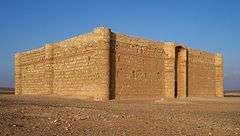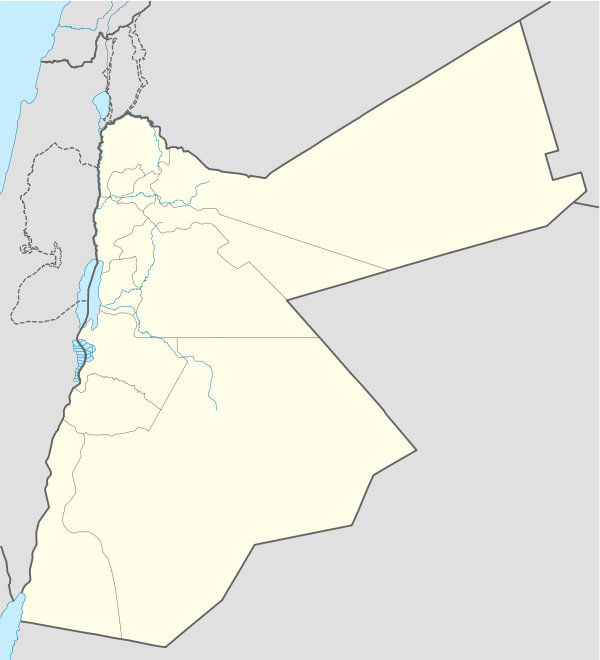Desert castles
The Umayyad Desert Castles, of which the Desert Castles of Jordan represent a prominent part, are fortified palaces or castles in what was the then Umayyad province of Bilad ash-Sham. Most Umayyad "desert castles" are scattered over the semi-arid regions of north-eastern Jordan, with several more in Syria, Israel and the West Bank (Palestine).
Brief description
The castles were built roughly between 660 and 750, under the caliphs of the Umayyad dynasty who had made Damascus their new capital in 661; after 750 the capital moved to the newly-built Baghdad, and some of the buildings were never completed. The Umayyads erected a number of characteristic palaces, known in Arabic as qusur (pl.)/qasr (sing.), some in the cities, but mostly in the semi-arid regions, and some along important roads. [1]
The generic term, "desert Castle," is not ideal, since it artificially separates similar qusur according to their location. Jordan possesses at least one urban Umayyad qasr on the Citadel Hill of Amman, while several qusur are located in Syria, the West Bank and Israel, either in cities (Jerusalem, Ramla), in relatively green areas (Al-Sinnabra, Khirbat al-Minya), or indeed in the desert (Qasr al-Hayr al-Gharbi and Qasr al-Hayr al-Sharqi, Jabal Sais, Hisham's Palace). The "desert castles" proper, i.e. isolated qusur built in arid regions, are chiefly located on the ancient trade routes connecting Damascus with Medina and Kufa.[2]
Types and purpose
With a few exceptions, the desert castles conform to a common template consisting of a square palace similar to Roman forts ("castra"), a bath house, water reservoir or dam, and often an agricultural enclosure. Some of the desert castles, for example Qasr Hallabat or Qasr Burqu', are rebuilt from remains of earlier Roman or Ghassanid structures; others are new constructions. The function and use of the buildings are today not entirely clear, and scholarship has suggested that they might have served a variety of defensive, agricultural, residential, recreational and commercial purposes. [3]
Given the variety observed in the archaeological record, it is unlikely that one single theory can explain the range of purposes of all the buildings. These functions include fortresses, meeting places for Bedouins (between themselves or with the Umayyad governor), badiyas (retreats for the nobles) or caravanserais. A proliferation of desert castles appeared around the same time as the number of caravans increased substantially. [4] Many seem to have been surrounded by natural or man-made oases and to have served as country estates or hunting lodges, given that hunting was a favoured pastime for the aristocracy. [5]
Their location along major routes and next to the very scarce water sources seems to indicate that they enabled the Umayyads to control the roads militarily, monitor and tax the seasonal movement of people and their livestock, and not least, impress travellers and local tribes with lavish displays of monumental architecture, baths and ponds in the middle of an arid landscape.[6]
Artistic value
The castles represent some of the most impressive examples of early Islamic art and Islamic architecture, and some are notable for including many figurative frescos and reliefs depicting people and animals, less frequently found in later Islamic art on such a large and public scale. Many elements of the desert palaces are on display in museums in Amman, in Jerusalem's Rockefeller Museum (decorations from Hisham's Palace) and the Pergamon Museum of Berlin (the Mshatta Facade).
Buildings

Partial list by main name:[7]
- Jordan
- Qusayr 'Amra, a "desert palace" about 85 km (53 mi) east of Amman, Jordan, important for frescos
- Qasr al-'Azraq, a "desert palace" about 100 km (62 mi) east of Amman, Jordan
- Qasr Burqu', a ruined qasr about 200 km (120 mi) east of Amman, Jordan
- Qasr el Feifeh
- Qasr al-Hallabat, a "desert palace" about 60 km (37 mi) northeast of Amman, Jordan
- Qasr Kharana, a "desert palace" about 65 km (40 mi) east of Amman, Jordan
- Qasr Mshatta, a "desert palace" about 35 km (22 mi) southeast of Amman, Jordan, with a large part of the Mshatta Facade now in the Pergamon Museum in Berlin
- Qasr Mushash or Qasr al-Muwaqqar, a "desert palace" about 30 km (19 mi) south of Amman, Jordan
- Qasr al-Qastal, a "desert palace" about 25 km (16 mi) south of Amman, Jordan
- Hammam as-Sarkh, a "desert palace" the bath complex of Qasr al-Hallabat, about 55 km (34 mi) northeast of Amman, Jordan
- Qasr at-Tuba, a "desert palace" about 95 km (59 mi) southeast of Amman, Jordan
- The Umayyad Palace, a qasr on the Citadel Hill of Amman, Jordan
- Umm al-Walid, a "desert palace" near Madaba, Jordan
- Qasr el `Uweinid, a desert castle, on the perimeter of the Azraq oasis, south-east of Amman, Jordan
- Syria
- Qasr al-Hayr al-Gharbi, a qasr in the Syrian Desert
- Qasr al-Hayr al-Sharqi, a qasr in the Syrian Desert
- Jabal Sais, a "desert palace" in Syria north of Azraq
- Israel and Palestine
- Hisham's Palace, in Arabic Qasr Hisham or Khirbet el-Mafjar, a "desert palace" on the West Bank near Jericho, Palestine
- Jerusalem, the four Umayyad qusur clustered around the southwest corner of the Temple Mount/Haram ash-Sharif
- Qasr al-Minya, a qasr on the Sea of Galilee, Israel
- Al-Sinnabra, a qasr on the Sea of Galilee, Israel
See also
References
- ↑ Khouri, R.G., The Desert Castles: A Brief Guide to the Antiquities, Al Kutba, 1988. pp 4-5
- ↑ Teller, M., Jordan,Rough Guides, 2002 p. 200
- ↑ "Nomad Politics and the Residences of Abulmalik and Walid I, in Fred M. Donner (ed), The Articulation of Early Islamic State Structures, Oxon, Routledge, 2017
- ↑ Jordan: Annual, Volume 36, Dāʼirat al-Āthār al-ʻĀmmah, 1992, p. 317 (translated from French)
- ↑ Petersen, A, Dictionary of Islamic Architecture, Routledge, 2002, p. 239; Meyers, E.M. (ed.), The Oxford Encyclopedia of Archaeology in the Near East, Volume 5, Oxford University Press, 1997, p. 241
- ↑ The spatial analysis of a historical phenomenon: using GIS to demonstrate the strategic placement of the Umayyad "desert palaces". Mahmoud Bashir Abdallah Alhasanat, M. Sc. thesis, Universiti Sains Malaysia, 2009
- ↑ Kennedy, D. and Riley, D., Rome's Desert Frontiers, Routledge, 2012, pp 8-9l provides a comprehensive list of castles, forts, mosques and other major edifices
